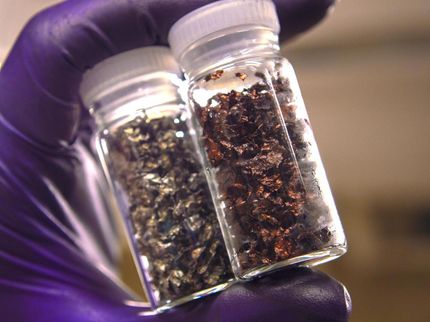Recycling batteries with citric acid
Highly efficient recycling process for NCM lithium-ion batteries
Advertisement
A simple, highly efficient, inexpensive, and environmentally friendly process could provide a viable pathway for the sustainable recycling of depleted lithium-ion batteries (LIBs): No chemicals beyond citric acid need to be added to leach out and separate over 99 % of the lithium, nickel, cobalt, and manganese metals contained in NCM batteries. The resulting recycled material can be directly converted into NCM electrodes, reports a research team in the journal Angewandte Chemie.
From smartphones to electric vehicles, lithium-ion batteries are everywhere in our daily lives. They are also an important component of our transition to renewable energy, as they are used to store excess solar and wind energy and send it back into the power grid on demand. The downside is that their limited lifespan results in vast numbers of spent LIBs that contain dangerous heavy metals and other hazardous materials. In addition, metal resources are being depleted.
Most recycling processes suffer from high energy usage, high emissions, and limited or low-quality recovered material. Or they require very large amounts of chemicals, are complicated and expensive, and produce toxic gases and run-off. Leaching with biocompatible acids like citric acid is one alternative to these processes. However, conventional processes (chelation-gel process) require a significant excess of the acid, and the pH value must constantly be adjusted with ammonia—complicated and not very environmentally friendly.
A team at China University of Mining and Technology (Beijing), Fuzhou University, Beijing University of Chemical Technology, and Tsinghua University, Shenzhen (China) led by Guangmin Zhou and Ruiping Liu has now developed a novel citric-acid-based method for the leeching, separation, and reclamation of metals from NCM cathodes. NCM is a mixed oxide containing nickel, cobalt, and manganese in a lamellar structure. Lithium ions are enclosed between the layers.
The trick to their method: Instead of leeching with an excess of citric acid like conventional methods, they use a relatively small amount. Because of this, only two of the three acid groups in the citric acid dissociate. The released protons break up the lithium-oxygen bonds, releasing lithium ions from the NCM into the solution. Bonds between the other metal ions and the oxygen ions are also broken. Nickel, cobalt, and manganese enter the solution, where they are bound into stable complexes by the citric acid anions. The third acid group of the citric acid then reacts with the hydroxyl group on the same molecule. A ring closure occurs in an intramolecular esterification (Fischer lactonization) reaction. This facilitates the reaction of the intermediates with each other to make a polyester, which gels into solid particles that can easily be separated out. Energy consumption and CO2 emissions are significantly less than in conventional hydrometallurgical recycling processes.
The gel can subsequently be heated to burn off the organic fragment. This results in a new NCM lamellar framework with included lithium ions, which can be used as a high-quality electrode material.
Original publication
Other news from the department science
These products might interest you
Most read news
More news from our other portals
See the theme worlds for related content
Topic World Battery Technology
The topic world Battery Technology combines relevant knowledge in a unique way. Here you will find everything about suppliers and their products, webinars, white papers, catalogs and brochures.

Topic World Battery Technology
The topic world Battery Technology combines relevant knowledge in a unique way. Here you will find everything about suppliers and their products, webinars, white papers, catalogs and brochures.




































































